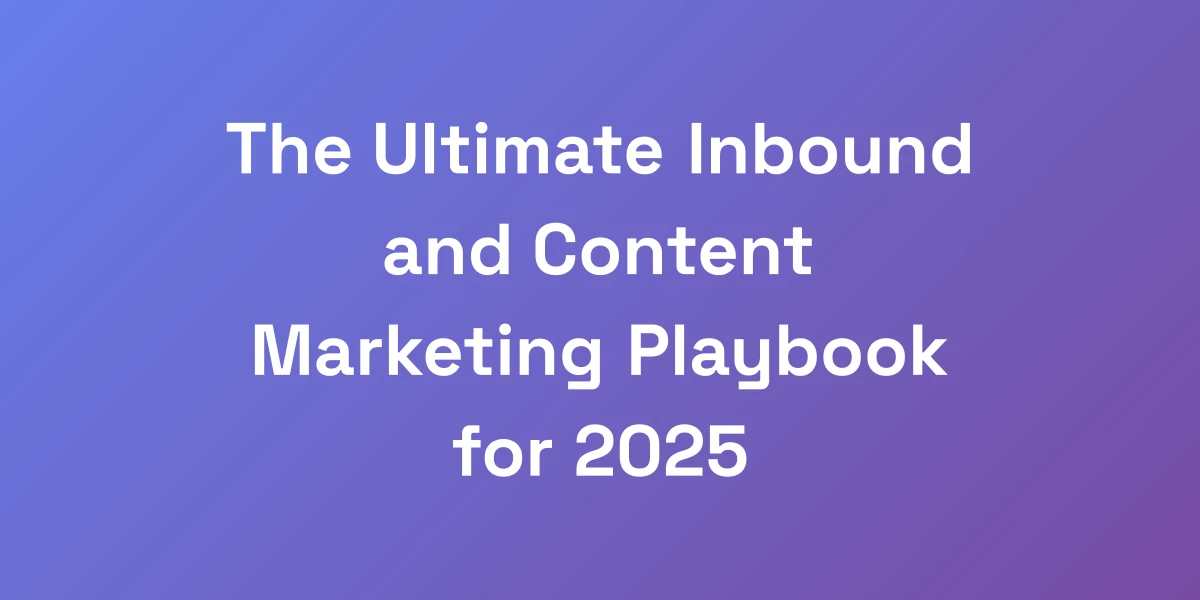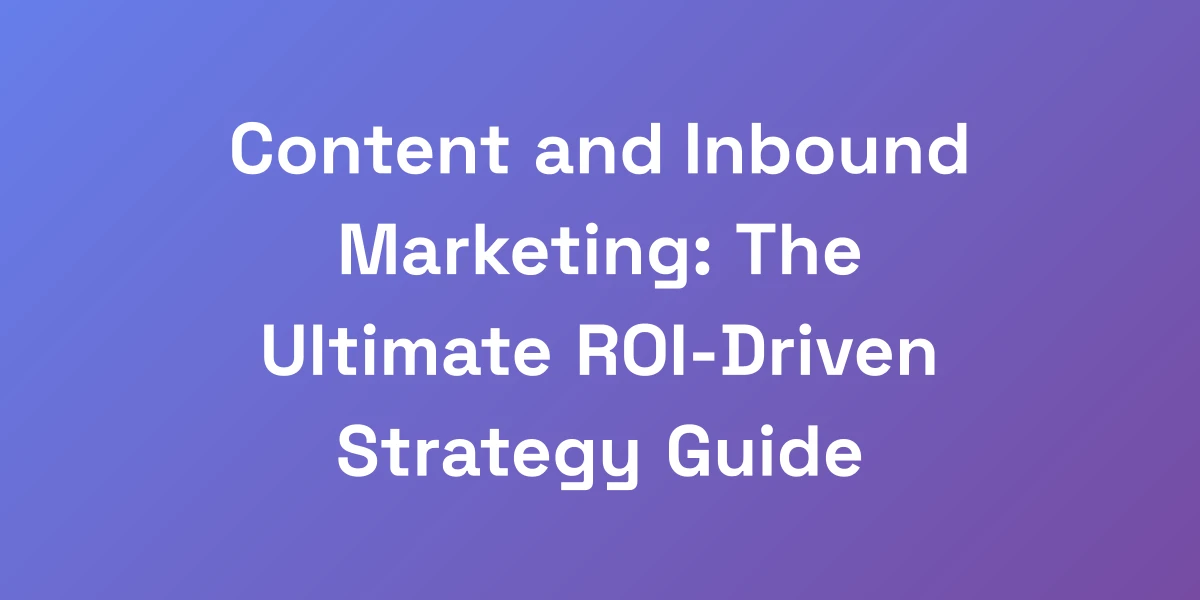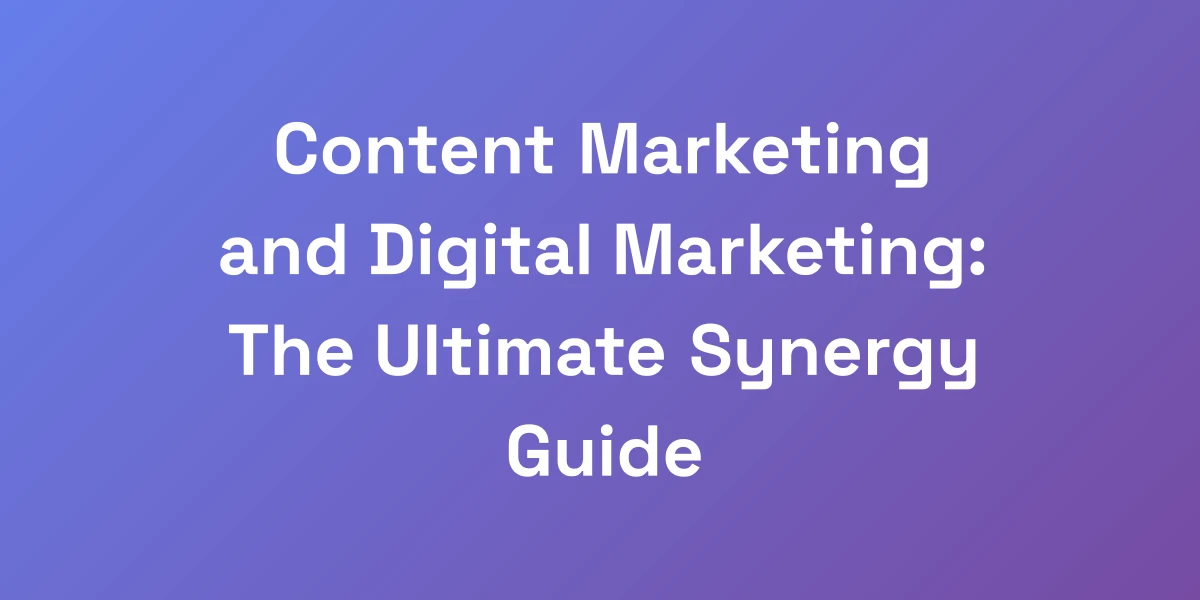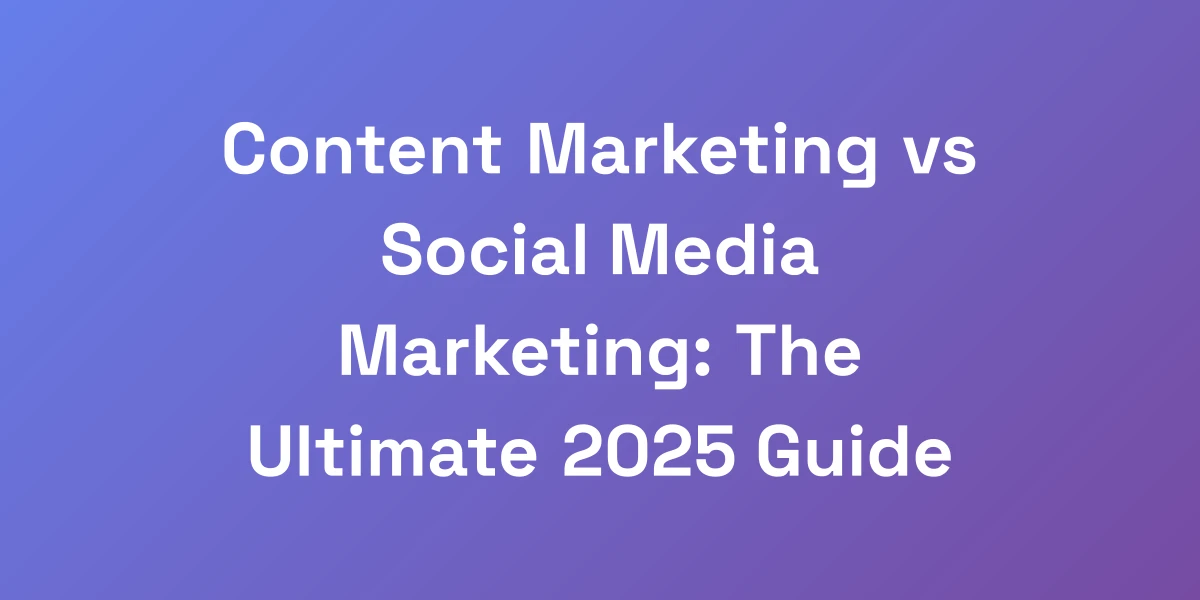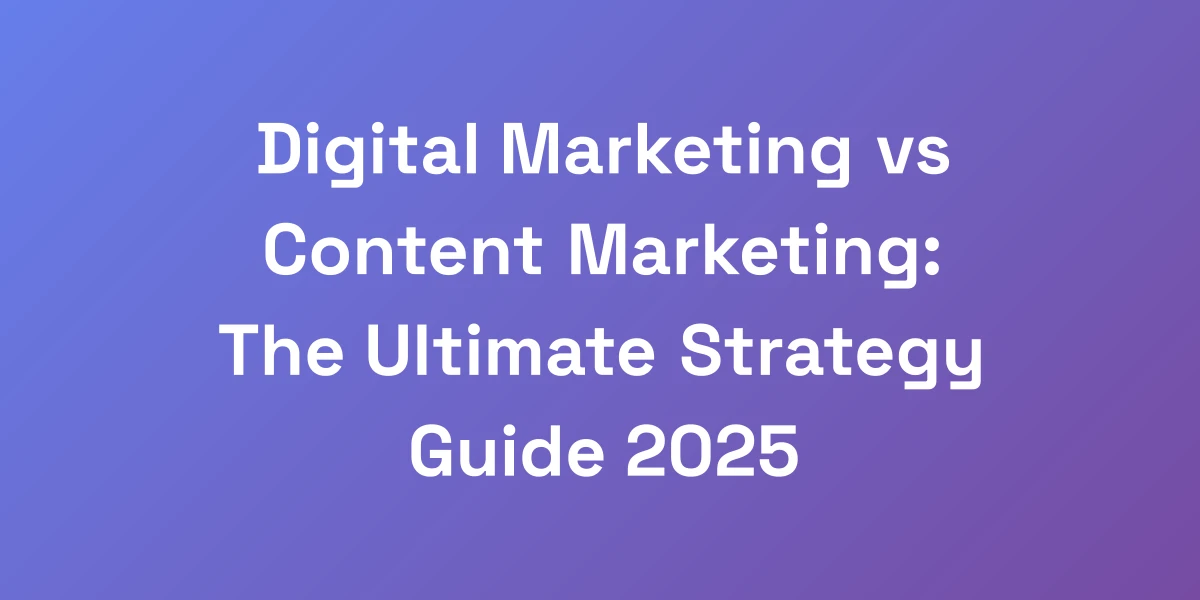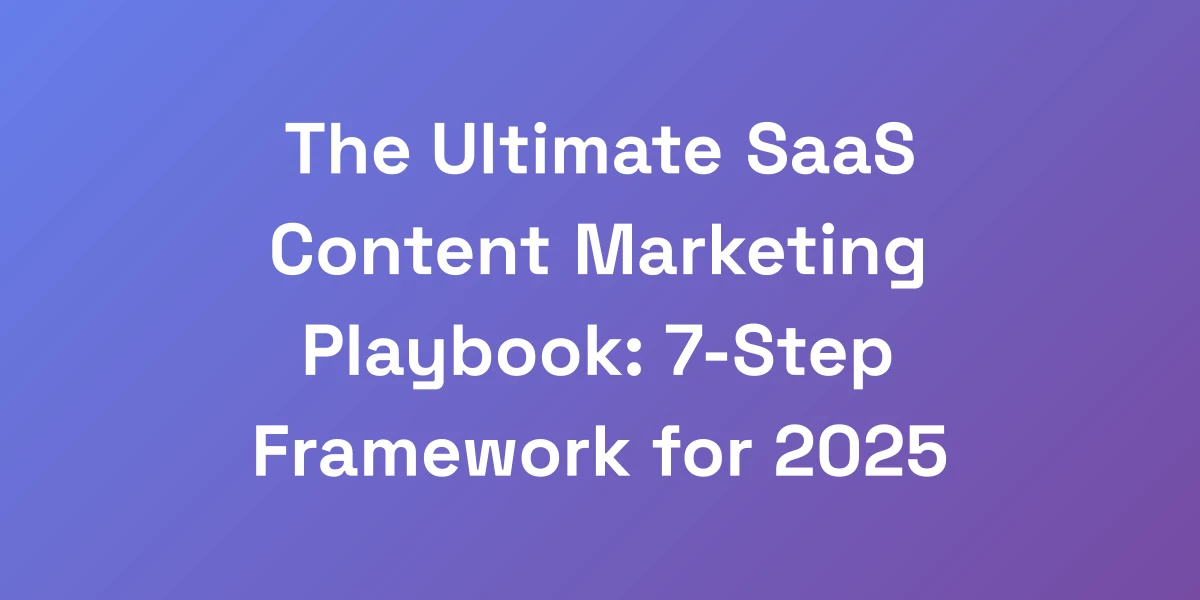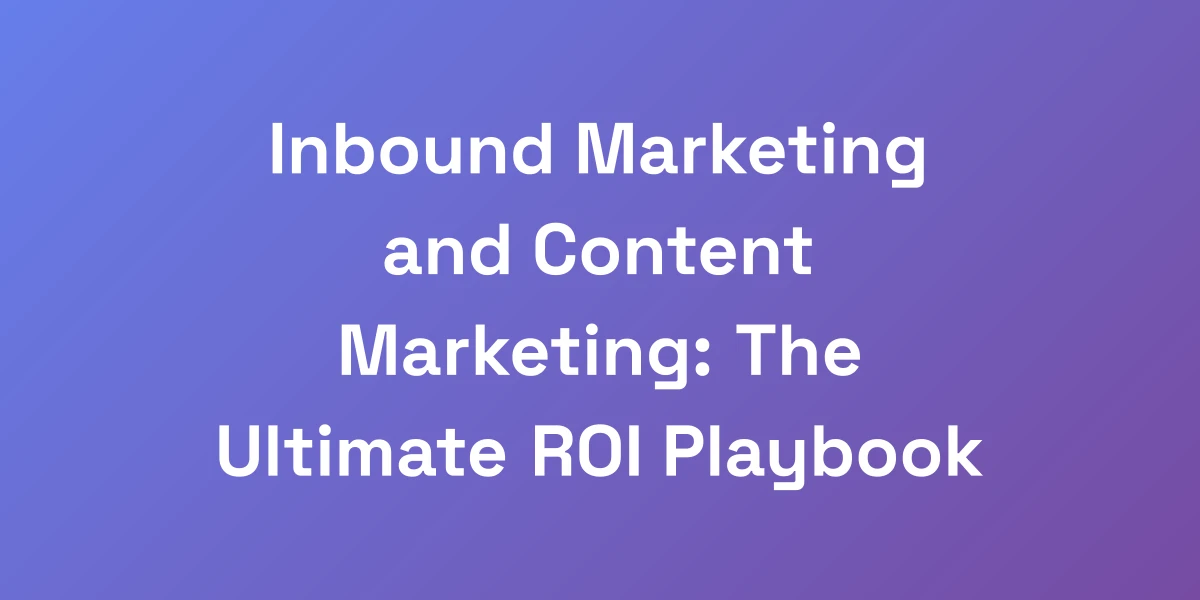
Inbound Marketing and Content Marketing: The Ultimate ROI Playbook
Mar 28, 2025 | By [email protected]
We’re not here to play small when it comes to your business’s growth. If you’re still shuffling between inbound marketing and content marketing like they’re separate games, you’re seriously missing out. Let’s face it: content marketing is the powerhouse that fuels your entire inbound strategy.
Imagine your content as the engine in a high-performance vehicle. Without it, your inbound marketing efforts sputter and stall. But when you combine them, what do you get? A well-oiled, revenue-generating machine that operates around the clock, even when you’re catching some Z’s.
We’ve seen businesses multiply their ROI tenfold by harnessing the synergy between inbound and content marketing. It’s not about choosing one over the other; it’s about leveraging their symbiotic relationship to create an unstoppable customer acquisition system that literally prints money while you sleep.
Ready to dive deep and uncover how you can transform your marketing strategy into a high-return investment machine? Let’s break it down step by step.
The Million-Dollar Marriage: Understanding Inbound and Content Marketing Synergy
Let’s cut through the noise. Inbound and content marketing aren’t just buzzwords tossed around in marketing meetings. They’re the dynamic duo that, when combined, can skyrocket your business’s growth. Here’s why treating them as interconnected strategies is a game-changer.
The Core Principles That Drive Both Strategies
At their heart, both inbound and content marketing share a common goal: to attract, engage, and delight customers. Inbound marketing focuses on understanding and addressing the needs of your prospects and customers, pulling them toward your business through valuable content and experiences.
Content marketing, on the other hand, is the art and science of creating and distributing relevant, valuable content to attract and retain a clearly defined audience. Together, they create a seamless journey from awareness to conversion, ensuring that potential customers are nurtured every step of the way.
Why Most Businesses Fail at Integration
Despite the clear benefits, many businesses stumble when trying to integrate inbound and content marketing. Common pitfalls include lack of alignment between teams, inconsistent messaging, and failure to track and measure performance effectively.
Another major issue is the neglect of the customer journey. Without a deep understanding of your audience’s needs at each stage, your content can miss the mark, leaving prospects disengaged and uninterested.
The Revenue Impact of Unified Strategy
When inbound and content marketing work in harmony, the revenue impact is profound. Businesses that integrate these strategies report higher lead quality, increased conversion rates, and lower customer acquisition costs.
Think of it as a well-coordinated orchestra where each instrument plays its part to create a symphony. The unified strategy ensures that every piece of content serves a purpose, driving your business towards sustainable growth and profitability.
Key Metrics That Matter in 2025
Understanding the right metrics is crucial for measuring the success of your integrated strategy. By 2025, the following metrics will be key:
- Customer Lifetime Value (CLV): Understanding the total value a customer brings over their entire relationship with your business.
- Conversion Rate: The percentage of visitors who take a desired action, such as filling out a form or making a purchase.
- Engagement Metrics: Includes metrics like time on page, social shares, and comment interactions that indicate how engaged your audience is with your content.
- Lead Generation: The number of new leads generated through your inbound and content marketing efforts.
- Return on Investment (ROI): A direct measure of the profitability of your marketing strategies.
Real Numbers: ROI Comparison of Integrated vs. Separated Approaches
Let’s get into some hard-hitting numbers. According to HubSpot via Demand Metric, content marketing generates three times the amount of leads as outbound marketing while costing 62% less. Furthermore, Invesp reports that inbound leads cost 61% less than outbound leads.
Marketers who prioritize blogging are 13 times more likely to see a positive ROI, as per UserGuiding. These statistics paint a clear picture: integrating inbound and content marketing doesn’t just enhance your strategy—it significantly boosts your bottom line.
Content Marketing: Your Inbound Strategy’s Secret Weapon
Here’s where most marketers drop the ball. Content marketing isn’t just churning out blog posts or creating eye-catching infographics. It’s about building a strategic asset that appreciates in value over time.
When you create content with a clear intention, it transforms into a lead-generating machine that operates 24/7. Businesses have revolutionized their revenue models by recognizing that content is the fundamental building block of modern customer acquisition. Let’s uncover the blueprint that has generated millions in revenue for our clients.
High-Impact Content Types That Drive Inbound Success
Not all content is created equal. To drive inbound success, you need to focus on content types that deliver the highest impact:
- Blog Posts: These are the backbone of your content strategy, providing valuable information that attracts and engages your audience.
- eBooks and Whitepapers: In-depth resources that establish your authority and provide substantial value, encouraging leads to exchange their contact information.
- Webinars and Live Streams: Interactive content that fosters real-time engagement and positions your brand as a thought leader.
- Videos: Highly engaging and shareable, videos cater to the growing preference for visual content.
- Infographics: These visually appealing formats make complex information easily digestible and shareable.
Content Distribution Frameworks That Scale
Creating great content is just the beginning. You need a robust distribution framework to ensure it reaches the right audience:
- Owned Channels: Your website, blog, and social media profiles are prime real estate for distributing content.
- Earned Media: Gain exposure through guest posts, media coverage, and influencer partnerships.
- Paid Promotions: Amplify your content’s reach through targeted advertising and sponsored posts.
- Email Marketing: Directly engage your audience by delivering personalized content to their inboxes.
By scaling your content distribution, you ensure consistent visibility and continuous lead generation, driving your inbound strategy forward.
Conversion-Focused Content Strategy
Creating content that merely attracts visitors isn’t enough. You need to focus on content that drives conversions:
- Call-to-Actions (CTAs): Strategic placement of CTAs guides your audience towards taking desired actions, whether it’s signing up for a newsletter or downloading an eBook.
- Landing Pages: Dedicated pages optimized for conversions provide a seamless path for visitors to become leads.
- Lead Magnets: Offering valuable resources in exchange for contact information incentivizes visitors to engage further with your brand.
- Personalization: Tailoring content to meet the specific needs and preferences of your audience increases relevance and boosts conversion rates.
By prioritizing conversion in your content strategy, you not only attract visitors but also transform them into committed customers.
Content ROI Measurement Systems
To truly understand the effectiveness of your content marketing efforts, you need robust ROI measurement systems:
- Google Analytics (GA4): Track website traffic, user engagement, and conversion metrics to gain deep insights into content performance.
- BuzzSumo: Monitor content performance and identify top-performing topics and formats, helping you refine your strategy.
- Semrush: Use keyword analytics to track how your content ranks and performs in search engine results, optimizing accordingly.
- Instagram Insights: Measure engagement and audience demographics for your social media content, ensuring it resonates with your target audience.
Implementing these tools allows you to make data-driven decisions, optimizing your content strategy for maximum ROI.
Advanced Content Optimization Techniques
Staying ahead requires continuous optimization. Here are some advanced techniques to take your content to the next level:
- SEO Keyword Integration: Use semantic search, long-tail keywords, and keyword clustering to align your content with user intent and improve search engine rankings. For specialized needs like SEO optimization near me, tailor your keywords to target local audiences effectively.
- Content Clustering: Organize content around core topics and subtopics to enhance authority and improve SEO performance.
- A/B Testing: Experiment with different headlines, CTAs, and formats to identify what resonates best with your audience.
- User Experience (UX): Ensure your content is easily accessible, mobile-friendly, and visually appealing to keep visitors engaged.
By implementing these optimization techniques, you ensure your content remains relevant, engaging, and highly effective in driving conversions.
Content Repurposing for Maximum Impact
Maximizing the value of your content means repurposing it across multiple formats and channels:
- Turning Blog Posts into Videos or Infographics: Convert written content into visual formats to reach different audience segments and increase shareability.
- Utilizing User-Generated Content (UGC): Encourage your audience to share their experiences and repurpose their content as testimonials or social proof.
- Repurposing Webinars into Podcasts or eBooks: Extend the lifecycle of your webinars by turning them into podcasts or comprehensive eBooks, increasing their reach and impact.
Repurposing not only extends the shelf life of your content but also ensures it reaches a broader audience, maximizing your return on investment.
The Inbound Marketing Ecosystem: Beyond Just Content
Here’s the naked truth: content alone won’t build a formidable inbound marketing strategy. You need a systematic approach that transforms your content into a cohesive customer acquisition machine.
Imagine your marketing efforts as an ecosystem where every component works in harmony. This synergy multiplies your results, allowing you to achieve 5-10x returns on your marketing investments.
Let us guide you on how to create an inbound system that generates predictable revenue growth, integrating all essential components seamlessly.
Strategic Framework for Inbound Success
A robust strategic framework is the foundation of any successful inbound marketing ecosystem:
- Define Your Buyer Personas: Conduct research to create detailed profiles of your ideal customers, including demographics, behaviors, and pain points.
- Audit Existing Content: Evaluate your current content to identify gaps, opportunities, and areas for improvement.
- Set Clear Goals: Establish specific, measurable, achievable, relevant, and time-bound (SMART) goals for your inbound and content marketing efforts.
- Develop a Content Strategy: Outline your content themes, types, and distribution channels based on your buyer personas and goals.
By laying out a clear framework, you ensure that every marketing activity is purposeful and aligned with your overall business objectives.
Technical Infrastructure Requirements
Behind every successful inbound marketing strategy lies a solid technical infrastructure:
- Marketing Automation Tools: Platforms like HubSpot or Marketo help automate email campaigns, social media posts, and lead nurturing workflows.
- Customer Relationship Management (CRM) Systems: Tools like Salesforce or Zoho CRM keep track of customer interactions and manage relationships effectively.
- Content Management Systems (CMS): Systems like WordPress or Drupal make it easy to create, manage, and publish content.
- Analytics Tools: Tools like Google Analytics and Semrush provide insights into your marketing performance and help you make data-driven decisions.
Investing in the right technical tools ensures that your inbound marketing efforts are efficient, scalable, and measurable. For those seeking inexpensive SEO services, integrating cost-effective tools can optimize your budget while maintaining high performance.
Lead Nurturing Automation Systems
Automation is the secret sauce that turns leads into loyal customers:
- Automated Email Campaigns: Send targeted emails based on user behavior and preferences, keeping your brand top-of-mind.
- Lead Scoring: Automatically score leads based on their interactions with your content, allowing you to prioritize high-quality leads.
- Personalized Content Delivery: Tailor content recommendations based on the user’s journey stage and interests, enhancing engagement and conversion rates.
- Workflow Automation: Streamline lead qualification and follow-up processes to ensure timely and relevant engagement.
By nurture leads efficiently, reducing manual effort and increasing the likelihood of conversion.
Customer Journey Optimization
Optimizing the customer journey ensures a seamless and engaging experience from the first touch to the final conversion:
- Awareness Stage: Create informative and educational content that addresses your audience’s pain points and attracts their attention.
- Consideration Stage: Provide in-depth resources like case studies, webinars, and eBooks that help prospects evaluate your solutions.
- Decision Stage: Offer compelling CTAs, personalized demos, and detailed product information to facilitate the final decision-making process.
- Post-Purchase Stage: Engage customers with follow-up emails, surveys, and loyalty programs to encourage repeat business and referrals.
By tailoring your content and engagement strategies to each stage of the customer journey, you create a personalized and effective path to conversion.
Analytics and Performance Tracking
No marketing strategy is complete without robust analytics and performance tracking. Here’s how to keep tabs on your inbound marketing ecosystem:
- Set Up Conversion Tracking: Monitor key conversion points across your website and landing pages to understand what drives sales.
- Analyze Funnel Performance: Evaluate each stage of your marketing funnel to identify bottlenecks and opportunities for improvement.
- Use Dashboards and Reports: Create customized dashboards that provide real-time insights into your key performance indicators (KPIs).
- Iterate Based on Data: Use your analytics data to refine your strategies, optimize content performance, and improve overall marketing effectiveness.
With the right analytics in place, you can make informed decisions that enhance the efficiency and impact of your inbound marketing efforts.
Integration with Sales Processes
Aligning your marketing and sales teams is crucial for a cohesive inbound marketing ecosystem:
- Define Service Level Agreements (SLAs): Establish clear expectations for lead handoff and follow-up to ensure smooth collaboration.
- Shared Goals and Metrics: Align marketing and sales goals to ensure both teams are working towards the same objectives.
- Consistent Communication: Foster regular communication between marketing and sales to share insights, feedback, and updates.
- Integrated Tools: Use CRM systems that integrate with your marketing automation tools to provide a unified view of customer interactions.
By integrating your sales processes with your inbound marketing efforts, you create a seamless transition for leads, improving the chances of conversion and boosting overall revenue.
Implementation Blueprint: Your 90-Day Action Plan
Enough talk. It’s time to execute. We’re not providing theoretical fluff here—this is a 90-day roadmap that has helped our clients generate seven-figure returns from their inbound and content marketing efforts.
This isn’t about doing everything; it’s about focusing on the 20% of actions that drive 80% of your results. Here’s your step-by-step playbook:
Week 1-4: Foundation Building
- Define Buyer Personas: Conduct research to create detailed profiles of your ideal customers, including demographics, behaviors, and pain points.
- Audit Existing Content: Evaluate your current content to identify gaps, opportunities, and areas for improvement.
- Set Clear Goals: Establish specific, measurable, achievable, relevant, and time-bound (SMART) goals for your inbound and content marketing efforts.
- Develop a Content Strategy: Outline your content themes, types, and distribution channels based on your buyer personas and goals.
Building a solid foundation sets the stage for all your subsequent marketing activities, ensuring alignment and focus from the get-go.
Week 5-8: Content Creation and Distribution
- Create High-Quality Content: Develop a mix of blog posts, videos, infographics, and other content types that align with your strategy.
- Implement Your Content Calendar: Schedule your content creation and distribution to maintain consistency and regular engagement.
- Distribute Across Channels: Use your owned, earned, and paid media channels to maximize content reach and visibility.
- Leverage Social Media: Engage with your audience on social platforms, using content to spark conversations and build relationships.
Focus on producing and distributing content that resonates with your audience, driving engagement and attracting leads.
Week 9-12: System Optimization
- Analyze Performance Data: Use your analytics tools to assess how your content is performing against your goals.
- Optimize Content: Refine your content based on performance insights, focusing on what works and improving what doesn’t.
- Enhance Automation: Fine-tune your lead nurturing workflows and automation systems to improve efficiency and effectiveness.
- Align Marketing and Sales: Ensure seamless handoff of leads and ongoing collaboration between your marketing and sales teams.
Optimization ensures that your marketing systems are fine-tuned for maximum performance, driving continuous improvement and better results.
Common Implementation Pitfalls
Even with the best plans, pitfalls are inevitable. Here’s how to avoid common implementation mistakes:
- Lack of Alignment: Ensure that your marketing and sales teams are aligned in their goals and processes.
- Inconsistent Content: Maintain consistency in your content quality and publishing schedule to keep your audience engaged.
- Poor Tracking: Implement robust tracking systems to monitor performance and make data-driven decisions.
- Ignoring Feedback: Listen to your audience’s feedback and adjust your strategies accordingly to meet their needs.
Avoiding these pitfalls keeps your marketing efforts on track, ensuring steady progress towards your goals.
Success Metrics and KPIs
Define and track key performance indicators (KPIs) to measure your success:
- Lead Generation Rates: Monitor the number of new leads generated through your content and inbound marketing efforts.
- Conversion Rates: Measure how effectively your content is converting leads into customers.
- Engagement Metrics: Track metrics like time on page, social shares, and comments to gauge audience engagement.
- Revenue Growth: Assess the impact of your marketing efforts on overall revenue and profitability.
Tracking these metrics provides clear insights into your marketing performance, enabling continuous optimization and improvement.
Scaling Strategies
Once your system is optimized and delivering results, it’s time to scale:
- Expand Content Production: Increase the volume and variety of your content to reach a broader audience.
- Invest in Paid Promotions: Amplify your content’s reach through targeted advertising and sponsorships.
- Leverage Partnerships: Collaborate with influencers and industry partners to enhance your content’s credibility and reach.
- Enhance Automation: Further streamline your workflows and automation systems to handle increased demand and complexity.
Scaling effectively ensures that your inbound and content marketing efforts continue to grow and deliver increasing returns over time. For specialized niches, such as SEO for auto dealerships, targeted strategies can drive significant growth.
Conclusion
We’ve walked you through the intricacies of merging inbound marketing with content marketing to create a powerhouse strategy that drives exceptional ROI. From understanding the fundamental synergy between these two strategies to implementing a detailed 90-day action plan, the path to marketing mastery is clear.
By integrating inbound and content marketing, you’re not just attracting leads—you’re building a sustainable, revenue-generating machine that works tirelessly to grow your business. The metrics and case studies we explored underscore the undeniable benefits of this unified approach.
Now, it’s your turn. Take the insights and actionable strategies outlined here, and implement them in your own business. Start building your ultimate ROI playbook today and watch as your marketing efforts transform into a dominant force that propels your business to new heights.
Ready to take action? Reach out to us, share your experiences, or ask questions in the comments below. Let’s grow together and make your marketing strategies unstoppable.
